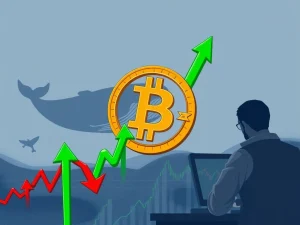Shocking Truth: How Covid Chaos Drove Michael Saylor to Bitcoin

Discover the compelling story behind Michael Saylor’s pivotal decision to invest MicroStrategy’s substantial cash reserves into Bitcoin. The Covid-19 pandemic brought unprecedented economic disruption, and for the MicroStrategy founder, it triggered a profound re-evaluation of traditional finance and asset holding. This period of uncertainty and aggressive central bank actions ultimately led to the development of the now-famous Saylor Bitcoin strategy.
The Economic Storm: Covid and Money Printing
According to Michael Saylor, the global lockdowns and economic policies enacted during the Covid-19 pandemic created what he termed a “war on currency.” While many focused on the health crisis, Saylor observed a different battle unfolding – one against the value and stability of traditional money. Interest rates were pushed to near zero, and central banks engaged in significant quantitative easing, essentially printing vast amounts of money.
Saylor described 2020 as a period of significant divergence. While small businesses and workers struggled under restrictions, financial markets saw a surge, fueled by the influx of liquidity. This led to what he called “hyperinflation in financial assets,” benefiting investors and traders while eroding the purchasing power of cash.
Holding half a billion dollars in cash reserves, MicroStrategy faced a dilemma. With zero interest rates, this significant asset was yielding nothing. Saylor felt he had to choose between a “fast death or a slow death” for his company’s capital, realizing that holding cash was no longer a viable long-term strategy in this environment of money printing Bitcoin narratives began to gain traction as an alternative.
Searching for a Solution: Why Not Gold or Real Estate?
Faced with the depreciation of cash, Saylor sought an asset that could preserve economic energy over time. He wanted to own something tangible or scarce, but traditional options presented challenges. Real estate and stock portfolios had already seen significant price increases due to the low-interest rate environment.
Finding and acquiring $500 million worth of alternative assets like fine art was impractical due to liquidity and scale issues. Saylor needed a highly liquid, fungible asset capable of storing value indefinitely. This search for a non-sovereign store of value led him to explore possibilities beyond conventional markets.
The Shift to Michael Saylor Bitcoin Investment
Initially skeptical of cryptocurrency, viewing it as a “scam coin” during the 2018 bear market, Saylor’s perspective shifted dramatically in 2020. Witnessing the economic upheaval and the response from central banks, he began intensive research into Bitcoin. He studied through various resources, concluding that Bitcoin represented the best available non-sovereign bearer instrument for storing value, a role historically played by gold but now potentially superseded by digital scarcity.
This deep dive culminated in MicroStrategy’s first significant Bitcoin purchase in August 2020, acquiring 21,454 BTC for $250 million. This marked the beginning of MicroStrategy’s aggressive accumulation strategy, positioning the company as the largest corporate holder of Bitcoin globally. The decision was a direct response to the economic conditions catalyzed by the pandemic and the subsequent monetary policies, solidifying the link between Covid Bitcoin investment motivations.
MicroStrategy Bitcoin Holdings Today
Following the initial purchase, MicroStrategy has continued to acquire Bitcoin, significantly increasing its holdings over time. The company’s commitment to Bitcoin as a primary treasury reserve asset has made headlines and influenced other corporations to consider similar strategies. The MicroStrategy Bitcoin accumulation has become a case study in corporate treasury management in an era of uncertain fiat currency value.
As of recent reports, MicroStrategy holds a substantial amount of Bitcoin, currently valued in the tens of billions of dollars. This aggressive adoption highlights Saylor’s conviction in Bitcoin’s long-term potential as a hedge against inflation and currency devaluation, a conviction born directly from the economic fallout of the pandemic and the subsequent monetary policy responses.
Conclusion: A Strategy Forged in Chaos
Michael Saylor’s journey to Bitcoin was not a sudden impulse but a calculated response to perceived threats to traditional wealth preservation posed by the economic environment of 2020. The chaos of the Covid-19 pandemic, coupled with unprecedented money printing and zero interest rates, exposed the vulnerabilities of holding large cash reserves. This forced Saylor to seek an alternative, leading him to embrace Bitcoin as a superior store of value for MicroStrategy’s treasury. His strategic shift underscores a growing sentiment among some investors and corporations regarding the future role of digital assets in a changing global economy.









